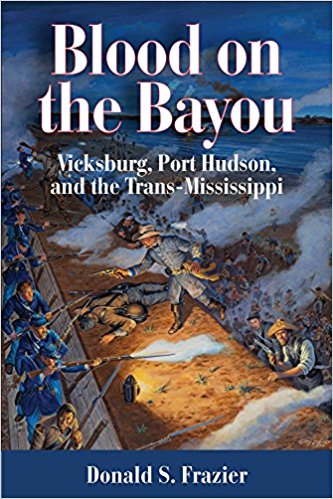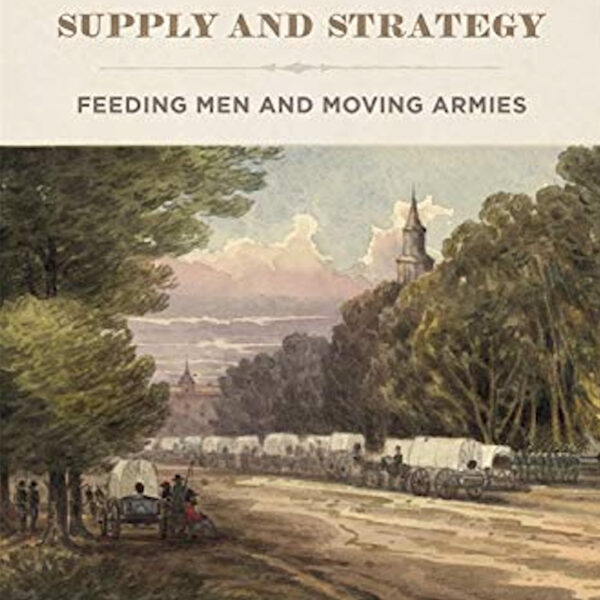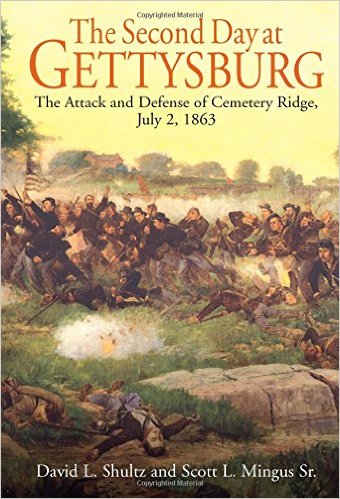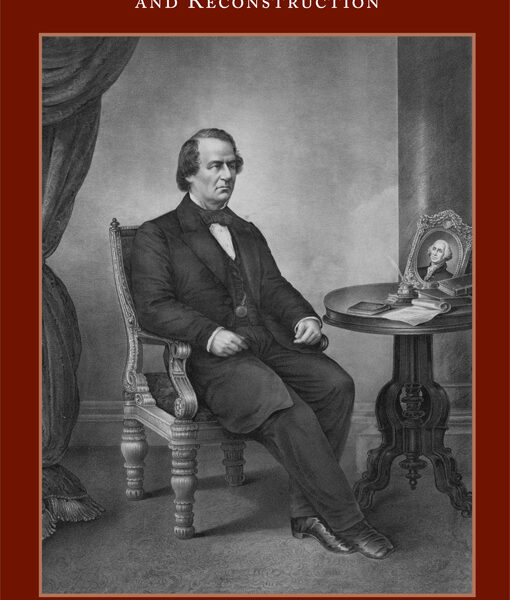Blood on the Bayou: Vicksburg, Port Hudson, and the Trans-Mississippi by Donald S. Frazier. State House Press, 2015. Cloth, ISBN: 978-1933337630. $39.99.
 Donald S. Frazier, a professor of History at McMurry University, is one of the leading scholars of the Trans-Mississippi Theater of the U.S. Civil War. Frazier’s first book, Blood and Treasure: Confederate Empire in the Southwest (1995) analyzed Confederate General Henry Hopkins Sibley’s New Mexico campaign as continuation of Manifest Destiny and a quest for an empire for slavery. Recently, Frazier has been working on the “Louisiana Quadrille,” a set of four volumes exploring Louisiana, Texas, and Mississippi during the U.S. Civil War. Blood on the Bayou, the third entry this series, follows Fire in the Cane Field: The Federal Invasion of Louisiana and Texas, January 1861-January 1863 (2009) and Thunder Across the Swamp: The Fight for the Lower Mississippi, February – May 1863 (2011).
Donald S. Frazier, a professor of History at McMurry University, is one of the leading scholars of the Trans-Mississippi Theater of the U.S. Civil War. Frazier’s first book, Blood and Treasure: Confederate Empire in the Southwest (1995) analyzed Confederate General Henry Hopkins Sibley’s New Mexico campaign as continuation of Manifest Destiny and a quest for an empire for slavery. Recently, Frazier has been working on the “Louisiana Quadrille,” a set of four volumes exploring Louisiana, Texas, and Mississippi during the U.S. Civil War. Blood on the Bayou, the third entry this series, follows Fire in the Cane Field: The Federal Invasion of Louisiana and Texas, January 1861-January 1863 (2009) and Thunder Across the Swamp: The Fight for the Lower Mississippi, February – May 1863 (2011).
Blood on the Bayou discusses the U.S. Civil War on the lower Mississippi, particularly the Vicksburg and Port Hudson campaigns. By placing these campaigns into a broader context, Frazier offers something for both military and social historians. Although most of the volume is devoted to a narrative of the campaigns, Frazier raises important themes in the first pages. He opens with a solid discussion of federal policies in Louisiana—specifically how the state became a laboratory for free labor. He also discusses emancipation and recruitment in Louisiana. This reviewer would have liked to see him develop these ideas at greater length.
The focus of Blood on the Bayou is asymmetrical. Frazier devotes most of the book to Port Hudson, with occasional Vicksburg interludes. Because scholars have written about the siege and capture of Vicksburg at great length and spent much less time on Port Hudson, Frazier successfully illuminates an often-overlooked element of the U.S. Civil War. However, one cannot help but feel Vicksburg is too removed from the narrative. This is somewhat odd, not only because of the greater numbers involved in the Vicksburg campaign, but also because both sides regarded the city as significant. Although Frazier might have paid a bit more attention to Vicksburg, his discussion of Port Hudson and Confederate General Richard Taylor’s rampaging in Louisiana to distract U.S. General Nathaniel P. Banks is informative and highly readable.
General Edmund Kirby Smith, the commander of the Trans-Mississippi Theater, was fortunate to have a talented subordinate like Richard Taylor. Still, despite being a good soldier and strategist, Taylor faced long odds. Taylor initially “planned to make Banks choose between Port Hudson and the largest city in the South [New Orleans]” (80). However, before he could attempt to dislodge Banks, Kirby Smith sent him to take command of Walker’s Texas Division and break Grant’s siege of Vicksburg. Taylor’s campaign achieved little of military significance and did nothing to help Vicksburg. However, the campaign proved, at the battle of Milliken’s Bend, that black regiments, “even raw and recently organized—would fight” (107). This fact heartened defenders of black troops and provided additional support for black recruitment.
Once Taylor returned to Louisiana, he designed a plan to distract Banks and break the siege of Port Hudson. Taylor had talented subordinates—Tom Green and James P. Major, for instance—but his senior subordinate, Alfred Mouton, was an ineffective commander. Furthermore, his small force “constituted the leavings of the Army of the Trans-Mississippi” (134). Nevertheless, Taylor proved that he could do much with little. His force went on an extended raid, captured Union bases and supplies, and panicked General Emory in New Orleans. Toward the end of the campaign, they set up cannons on the banks of the Mississippi to harass ships carrying supplies to Port Hudson. None of this moved Banks to break his siege, although he fretted about Confederates depredations in an area the Union should have locked down. The Union forces did not fare particularly well against Taylor’s men, although the doughty defenders of Fort Butler more than held their own against Tom Green’s Texans.
Even after the Union triumph at Port Hudson, when it became clear Taylor had to skedaddle if he wanted to live to fight another day, his force remained dangerous. His men bloodied the nose of the Union Army during the battle of Kock’s Plantation. Despite the victory, Taylor retreated and the Union did not pursue him very seriously. However, this should not detract from the fact that, with the fall of Vicksburg and Port Hudson and the Union victory at Gettysburg, “the reversal of Rebel fortunes in June and July 1863 had been breathtaking” (381). Frazier’s treatment of August 1863-February 1864 is rather cursory. Hopefully, he will deal with this period in additional depth in the subsequent volume.
Blood on the Bayou, Frazier admits in the Foreword, was not the book he intended to write. In the planning stage, he envisioned “a tidy—and conventional—telling of the U.S. Civil War in Louisiana and Texas from June 1863 to February 1864” (vii). However, as he read the sources, he discovered the reality was far more complex. The sources, he asserts, indicated an overriding concern with slavery, specifically, the control of people. Furthermore, “physical control of the slave population impacted how the Federal government conducted its military campaigns” (viii). These are very important points, and this reviewer wished Frazier had made them the focus of the volume. Good military history is absolutely essential to the study of the U.S. Civil War. However, Frazier might have balanced his narrative of military campaigns with analysis of army interactions with slaves and freedpeople.
The relative lack of attention to this important theme makes it difficult to evaluate whether or not the evidence supports his thesis. For instance, Frazier rarely mentions officers designing offensive or defensive plans based solely on physical control of the slave population. In other words, it might factor into their calculations, but it hardly seemed the most important factor. Case in point, he writes, “one of the largest concentrations of slaves lay in the Mississippi Valley and this population needed to be under Federal control. The Rebel forts at Vicksburg and Port Hudson were impediments” (viii). To suggest that the campaigns against Vicksburg and Port Hudson owed their existence to the desire to bring a large black population under control is provocative, but never fully proven. Indeed, were not these campaign the result of a desire to control rivers, connect the northern states with the Gulf of Mexico, and cut the Confederacy in two? Frazier observes that black people became, in a sense, “plunder” for the Union army (viii). If this was the case, most of the men Frazier wrote about manifested very little interest in black people and did not plan their campaigns around securing black bodies. Frazier is absolutely right to be fascinated by the redistribution of the black population. Without doubt, this is a very understudied topic. However, he needed more sustained analysis of this point.
Despite the issues outlined above, Blood on the Bayou has many strengths. Anyone interested in reading a clear and detailed narrative of the Port Hudson campaign and Taylor’s efforts to lift Banks’s siege must consult this volume. Frazier clearly knows more about the U.S. Civil War in Louisiana and Mississippi than most scholars. His “Louisiana Quadrille” is now the seminal work on the topic. Furthermore, the book is lavishly illustrated and contains dozens of maps, which are sure to appeal to readers. This is a book that will appeal to both a scholarly and a non-academic audience. In sum, Frazier has a thorough command of the confusing and often chaotic events of a theater that only recently has begun to receive more attention in the scholarly literature.
Evan C. Rothera received his Ph.D. from The Pennsylvania State University, and is at work on his first book.



